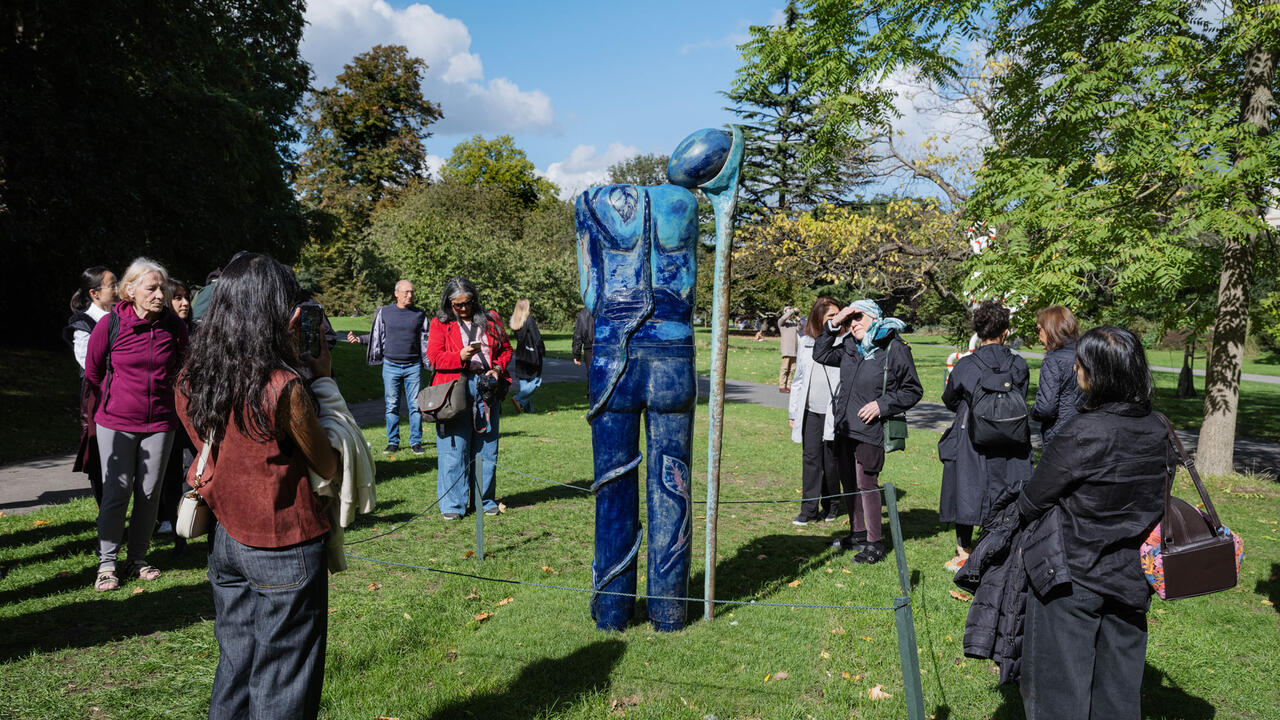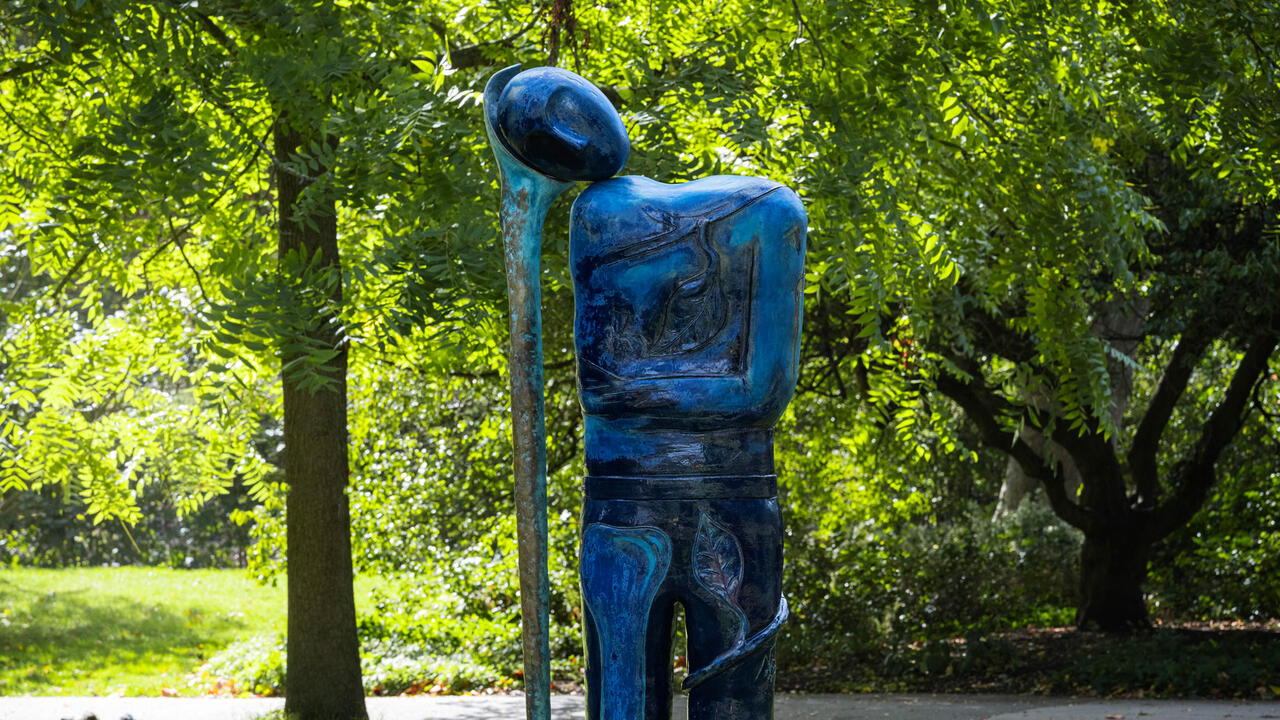Fake It Till You Make It: A Look Inside the 1st Anren Biennale
The staging of an international art biennial in Anren, China, contained both Potemkinist ambition and Brechtian drama
The staging of an international art biennial in Anren, China, contained both Potemkinist ambition and Brechtian drama

Long before its inaugural biennial opened last October, the Sichuanese town of Anren – on the outskirts of Chengdu, China – was the site of a very different kind of theatre. The town had been home to one of China’s early 20th-century landlords, Liu Wencai, who then became a pantomime villain in Mao-era historiography (validating the expropriation of his properties when the Communists came to power). The luxury spoils from Liu’s Anren estate were being exhibited in the town as early as the 1950s, as demonstrations of the corruption of pre-liberation China. But probably the most recognized demonization of Liu resides in the Rent Collection Courtyard sculptures, which are still on display in his Anren manor today. These 114 figures were made by art students in 1965 from local clay, constructing a diorama of Liu and his clawing cronies abusing tenant peasants: the sculptures became a Cultural Revolution icon, with replicas proliferating across the country.

The original Rent Collection Courtyard installation, in which socialist realism met older religious (hellish) iconography, soon transformed into a piece of savage drama, as the original artists intended. Each night, museum staff had to wipe away the spit of fuming visitors that drooled down Liu’s own statue. Liu’s manor became, as the scholar Haiyan Lee so well describes, ‘the heterotopia that brought the dark past into the present and enabled millions of Chinese to relive the horror of class exploitation and oppression’. From the 1980s, the more sensationalist horror elements of the preserved Liu manors – the nail studded cages and ‘bloody’ wall markings – began to disappear. And the arrival of the private Jianchuan Museum Cluster in the 2000s, which is host to a sizeable collection of Cultural Revolution artefacts – and reportedly a ‘Commune’ restaurant and daily broadcasts of ‘red songs’ – heralded Anren’s new Disneyfied shift. (The municipal government even once encouraged townsfolk to wear period dress.) When I visited, the town blended its older voyeuristic texture with a more recent economy of distraction.
The choice of Anren might seem an anomaly even within the sprawling geography of China’s art biennial boom. But the Party has increasingly set its sights on state-supported ‘red tourism’ over the last decade, which in China forms a deeply politicized set of heritage sites stretching from Shaoshan to Yan’an. And in the biennial catalogue, the exhibition’s own sponsors, the state-owned Overseas Chinese Town Enterprises, promise that their investment of 10 billion RMB in future construction for the town will include a new eco-village and film industry complex. If the selling of places is also bound up in the staging of giant Potemkinist spectacles to project ambitions of new prosperity and influence, what role might an international art biennial staged in a former factory space a stone’s throw from the clusters of landlord manors and tourist-tat shops play?

And so, to the biennial, titled ‘Today’s Yesterday’ and overseen by the art historian Lu Peng, which is composed of a set of independently curated exhibitions. This is not the place to offer a full description of the giant and obvious Chinese art-world howlers which crammed a good half of the biennial. From Sui Jianguo’s monstrous Mao jacket monoliths (begun 1997) through to the cheap globules of Chen Wenling’s Zhaozhou Bridge (2014–17) in which writhing Chinese mythical beasts and an inverted Statue of Liberty form an arc of polished steel over the outdoor entrance to the exhibitions, cynical intentions weren’t easy to miss.
There was, however, plenty to counter these brasher impulses. Sometime during the preview, I came across a screening of Clemens von Wedemeyer and Maya Schweizer’s film Metropolis, Report from China (2006). It’s a nocturnal essay that melts between the urban visions of Fritz Lang’s 1926 Metropolis and the pace of Chinese urbanization which the German filmmakers witnessed as they travelled from Beijing to Shanghai in 2004, collecting interviews with migrant workers and architects.

I was almost expecting a shallow parable about the unclear line between fictional and capitalist violence, but Von Wedemeyer and Schweizer’s splicing of neon-smeared Chinese urbanscapes and Lang’s city – architectural machines in which labourers are kept below ground and elites take pleasure in the light – was as much a powerful commentary on the shifting imagination in Western cinematic dystopias. If, in the 1920s, Lang had sighted dystopia in New York’s cityscape, for filmmakers today the Asian megalopolis dominates, balancing precariously between visions of inequality and futurism. It’s an image which curiously also mirrors the Chinese state’s own conflict between its debt to cheap exploited labour, fantasies of authoritarian bio-politics and feverish real estate speculation.

At the Anren Biennale, the exhibition ‘The Szechwan Tale: Theatre and History’, curated by Marco Scotini, loudly trumpeted the region’s connection to the German dramatist Bertolt Brecht. After watching the Chinese opera master Mei Lanfang perform in Moscow in 1935, Brecht began reflecting on the ‘alienation effect’ in Chinese dramaturgy: marked by deep symbolism, gestures and masks, and a distancing between audience and performance. Brecht’s fascination with China extended from theatrical principles to reading the philosophy of Confucius and Mao, and the settings of several of his plays. His 1941 morality drama The Good Person of Szechwan is often regarded by commentators as belonging to an imagined, exoticized landscape, but that misses the nuances of Brecht’s world-building – his China is not quite reality, nor plain old fiction.
The non-space occupied by Brecht’s imagined China is a worthy subject, but ‘The Szechwan Tale: Theatre and History’ ends up with a vaguer pick-and-mix. The exhibition’s entrance is dominated by a clothes rack lined with Chinese opera and ballet costumes – in Michelangelo Pistoletto’s Wardrobe (2017), you can put these colourful tunics and hats on before cosplaying your way through Céline Condorelli’s Theatrical Pieces (2017), a sequence of fragmented wooden stage sets, all bearing the domineering presence of hangman’s platforms, before reaching the billowing plush fabrics of Ulla von Brandenburg’s Curtain (2017). These are works that inadvertently invoke the performative and ritualized essence of the biennial itself.

Included in ‘The Szechwan Tale’, Beijing-based Yang Yuanyuan’s remarkable installation Nearly There, Nearly Concrete, Chongqing (2014–16) began with the artist’s visit to the Sichuanese city in which she purchased an album containing architectural photographs from the 1960s. The book became an ‘index for my wandering’ as Yang tried and failed to revisit sites across the city where the landscapes of the photographs had now completely disappeared. A few, though, still remained and, along with photographs of Chongqing’s abandoned steel and shipping factories, are collected by Yang into a three-dimensional montage that places the original album images alongside the artist’s documentation of the city today. Yang describes this act of collaging across decades as a process of ‘weaving’ through vanishing landscapes.
The exhibition ‘Crossroads’, curated by Liu Ding and Carol Yinghua Lu (a frieze contributing editor), does a better job of delivering its promised punches. Through a tightly structured series of works that complicate ideas of progressive promise, the curators argue that if the 20th century was an era marked by a genuine ideological crossroads, then today’s divergent and resurgent political paths are merely roads to nowhere. Daniel García Andújar’s complicated speculations on the making and unmaking of artistic canons in his wall installation, Atlas, The Disasters of War (2017), flow from a set of Francisco de Goya engravings into images of drone warfare, carpet bombing and the wartime evacuation of Madrid’s Prado Museum, while a series of adjacent films by Tomáš Rafa document the rise of extremist politics across Europe, from fascists marching in Poland once again through to Antifa protests in Berlin.

I spent much of my time wandering through the looming indigo paper towers of Adam Avikainen’s Kaki Kuchi (2015–ongoing), which conceal oyster shells and persimmon husks. Kaki Kuchi calls out from the artist’s small-town Japanese life in Kamiyama, once a place where indigo dye was grown and sold; now, Avikainen’s crumpled sculptures, drenched in the natural matter, act as musky triggers of past industry.
‘Crossroads’ finds an almost too perfect core in Grace Schwindt’s striking film Only a Free Individual Can Create a Free Society (2014), which began life as a conversation between Schwindt and an old family associate: a German activist who had once participated in postwar radical leftist movements, and is now a taxi driver. Their intimate, winding conversation veers from the political fabrications of social movements and debating what freedom meant in the 1960s through to a commentary on changing landscapes as the activist-turned-cabbie drives from the countryside towards the city. But its transcript, broadcast in tones bled of all expression, merely floats behind a dance performance filled with freaky costumes and shifting stage designs overlooking a starry London skyline.

At one point in Schwindt’s film, the stage might be frozen in a hail of glitter, at another it is occupied by deconstructed geometric sculptures and dancers robed in silvery peacock feathers. Throughout Only a Free Individual Can Create a Free Society, the twinkling lights of nighttime London are only glimpsed through window cut-outs. But in a final vignette, a car slams into the back of the stage, revealing the entire landscape beyond: it’s a moment of poignant deconstruction, and in a place like Anren, where disorientation and estrangement multiply, it contains much wisdom.
Main image: Qiu Zhijie, The Greeting, 2013, installation view. Courtesy: the artist and the Anren Biennale 2017
The 1st Anren Biennale runs until 28 February 2018 in the town of Anren, Sichuan, China.



















